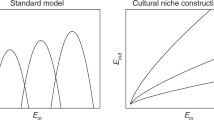Abstract
In the study reported here we examined the impact of population size and two proxies of risk of resource failure on the diversity and complexity of the food-getting toolkits of hunter–gatherers and small-scale food producers. We tested three hypotheses: the risk hypothesis, the population-size hypothesis, and a hypothesis derived from niche construction theory. Our analyses indicated that the toolkits of hunter–gatherers are more affected by risk than are the toolkits of food producers. They also showed that the toolkits of food producers are more affected by population size than are the toolkits of hunter–gatherers. This pattern is inconsistent with the predictions of both the risk hypothesis and the population-size hypothesis. In contrast, it is consistent with the predictions of the niche construction hypothesis. Our results indicate that niche construction has affected the evolution of technology in small-scale societies and imply that niche construction must be taken into account when seeking to understand technological variation among food producers and the technological changes that occurred in association with the various transitions to farming that have occurred over the last 10,000 years.




Similar content being viewed by others
References
Bailey HP (1960) A method of determining the warmth and temperateness of climate. Geogr Ann 42:1–16
Benjamini Y, Yekutieli D (2001) The control of false discovery rate under dependency. Ann Stat 29:1165–1188
Binford LR (2001) Constructing frames of reference: an analytical method for theory building using ethnographic and environmental data sets. University of California Press, Berkeley
Bleed P (2006) Living in the human niche. Evol Anthropol 15:8–10
Bleed P, Matsui A (2011) Why didn’t agriculture develop in Japan? A consideration of Jomon ecological style, niche construction, and the origins of domestication. J Archaeol Method Theory 17:356–370
Broughton JM, Cannon MD, Bartelink EJ (2010) Evolutionary ecology, resource depression, and niche construction theory: applications to central California hunter–gatherers and Mimbres–Mogollon agriculturalists. J Archaeol Method Theory 17:371–421
Collard M, Kemery MD, Banks S (2005) Causes of toolkit variation among hunter–gatherers: a test of four competing hypotheses. Can J Archaeol 29:1–19
Collard M, Buchanan B, Morin J, Costopolous A (2011) What drives the evolution of hunter–gatherer subsistence technology? A reanalysis of the risk hypothesis with data from Early Contact era populations in the Pacific Northwest. Philos Trans R Soc B 366:1129–1138
Cuddington K (2012) Legacy effects: the persistent impact of ecological interactions. Biol Theory 6. doi:10.1007/s13752-012-0027-5
d’Errico F, Stringer CB (2011) Evolution, revolution or saltation scenario for the emergence of modern cultures? Philos Trans R Soc B 366:1060–1069
Erwin DH (2008) Macroevolution of ecosystem engineering, niche construction and diversity. Trends Ecol Evol 23:304–310
Foley RA, Lahr MM (2011) The evolution of the diversity of cultures. Philos Trans R Soc B 366:1080–1089
Gerbault P, Liebert A, Itan Y, Powell A, Currat M, Burger J, Swallow DM, Thomas MG (2011) Evolution of lactase persistence: an example of human niche construction. Philos Trans R Soc B 366:863–877
Kendal J, Tehrani JJ, Odling-Smee J (2011) Human niche construction in interdisciplinary focus. Philos Trans R Soc B 366:785–792
Kline MA, Boyd R (2010) Population size predicts technological complexity in Oceania. Proc R Soc B 277:2559–2564
Laland KN (2008) Exploring gene–culture interactions: insights from handedness, sexual selection and niche-construction case studies. Philos Trans R Soc B 363:3577–3589
Laland KN, Brown G (2006) Niche construction, human behavior, and the adaptive-lag hypothesis. Evol Anthropol 15:95–104
Laland KN, O’Brien MJ (2010) Niche construction theory and archaeology. J Archaeol Method Theory 17:303–322
Laland KN, O’Brien MY (2012) Cultural niche construction: an introduction. Biol Theory 6. doi:10.1007/s13752-012-0026-6
Laland KN, Odling-Smee FJ, Feldman MW (2000) Niche construction, biological evolution, and cultural change. Behav Brain Sci 23:131–175
Laland KN, Odling-Smee FJ, Feldman MW (2001) Cultural niche construction and human evolution. J Evol Biol 14:22–23
Laland KN, Kendal JR, Brown GR (2007) The niche construction perspective: implications for evolution and human behaviour. J Evol Psychol 5:51–66
Laland KN, Odling-Smee FJ, Myles S (2010) How culture has shaped the human genome: bringing genetics and the human sciences together. Nat Rev Genet 11:137–148
McPherron SP, Alemseged Z, Marean CW, Wynn JG, Reed D et al (2010) Evidence for stone-tool-assisted consumption of animal tissues before 3.39 million years ago at Dikika, Ethiopia. Nature 466:857–860
Narum SR (2006) Beyond Bonferroni: less conservative analyses for conservation genetics. Conserv Genet 7:783–787
O’Brien M, Laland KN (2012) Genes, culture and agriculture: an example of human niche construction. Curr Anthropol (in press)
Odling-Smee FJ, Laland KN (2012) Ecological inheritance and genetic inheritance: what are they and how do they differ? Biol Theory 6. doi:10.1007/s13752-012-0030-x
Osborn AJ (1999) From global models to regional patterns: possible determinants of Folsom hunting weapon design diversity and complexity. In: Amick DS (ed) Folsom lithic technology: explorations in structure and variation. International Monographs in Prehistory, Ann Arbor, pp 188–213
Oswalt WH (1973) Habitat and technology: the evolution of hunting. Holt, Rinehart, and Winston, New York
Oswalt WH (1976) An anthropological analysis of food-getting technology. Wiley, New York
Peck JR, Barreau G, Heath SC (1997) Imperfect genes, Fisherian mutation and the evolution of sex. Genetics 145:1171–1199
Post DM, Palkovacs EP (2009) Eco-evolutionary feedbacks in community and ecosystem ecology: interactions between the ecological theatre and the evolutionary play. Philos Trans R Soc B 364:1629–1640
Read D (2008) An interaction model for resource implement complexity based on risk and number of annual moves. Am Antiq 73:599–625
Rendell L, Fogarty L, Laland KN (2011) Runaway cultural niche construction. Philos Trans R Soc B 366:823–835
Riede F (2011) Adaptation and niche construction in human prehistory: a case study from the southern Scandinavian Late Glacial. Philos Trans R Soc B 366:793–808
Riel-Salvatore J (2010) A niche construction perspective on the middle–upper paleolithic transition in Italy. J Archaeol Method Theory 17:323–355
Rowley-Conwy P, Layton R (2011) Foraging and farming as niche construction: stable and unstable adaptations. Philos Trans R Soc B 366:849–862
Schielke EG, Palkovacs EP, Post DM (2012) Eco-evolutionary feedbacks drive niche differentiation in the alewife. Biol Theory 6. doi:10.1007/s13752-012-0031-9
Shennan SJ (2001) Demography and cultural innovation: a model and some implications for the emergence of modern human culture. Cambridge Archaeol J 11:5–16
Shott M (1986) Technological organization and settlement mobility: an ethnographic examination. J Anthropol Res 42:15–51
Smith BD (2007a) Niche construction and the behavioral context of plant and animal domestication. Evol Anthropol 16:188–199
Smith BD (2007b) The ultimate ecosystem engineers. Science 315:1797
Smith BD (2009) Resource resilience, human niche construction, and the long-term sustainability of pre-Columbian subsistence economies in the Mississippi River valley corridor. J Ethnobiol 29:167–183
Smith BD (2011) General patterns of niche construction and the management of “wild” plant and animal resources by small-scale pre-industrial societies. Philos Trans R Soc B 1566:836–848
Smith BD (2012) A cultural niche construction theory of initial domestication. Biol Theory 6. doi:10.1007/s13752-012-0028-4
Torrence R (1983) Time budgeting and hunter–gatherer technology. In: Bailey G (ed) Hunter–gatherer economy in prehistory. Cambridge University Press, Cambridge, pp 11–22
Torrence R (1989) Re-tooling: towards a behavioral theory of stone tools. In: Torrence R (ed) Time, energy and stone tools. Cambridge University Press, Cambridge, pp 57–66
Torrence R (2001) Hunter–gatherer technology: macro-and microscale approaches. In: Panter-Brick C, Layton RH, Rowley-Conwy P (eds) Hunter–gatherers: an interdisciplinary perspective. Cambridge University Press, Cambridge, pp 73–98
Wollstonecroft M (2011) Investigating the role of food processing in human evolution: a niche construction approach. Archaeol Anthropol Sci 3:141–150
Woodburn J (1979) Minima politics: the political organization of the Hadza of north Tanzania. In: Shack WA, Cohen PS (eds) Politics in leadership: a comparative perspective. Clarendon Press, Oxford, pp 244–246
Woodburn J (1980) Hunters and gatherers today and reconstruction of the past. In: Gellner E (ed) Soviet and western anthropology. Duckworth, London, pp 95–117
Woodburn J (1982) Egalitarian societies. Man 17:431–451
Woodburn J (1988) African hunter–gatherer social organization: is it best understood as a product of encapsulation? In: Ingold T, Riches D, Woodburn J (eds) Hunters and gatherers I: history, evolution and social change. Berg, Oxford, pp 31–64
Zeder MA (2012) The broad spectrum revolution at 40: resource diversity, intensification, and an alternative to optimal foraging explanations. J Anthropol Archaeol 31:241–264
Acknowledgments
We thank Kevin Laland for his help with improving the original manuscript and for many conversations about NCT over the years. We also thank Melody Galen for drafting the figures.
Author information
Authors and Affiliations
Corresponding author
Rights and permissions
About this article
Cite this article
Collard, M., Buchanan, B., Ruttle, A. et al. Niche Construction and the Toolkits of Hunter–Gatherers and Food Producers. Biol Theory 6, 251–259 (2011). https://doi.org/10.1007/s13752-012-0034-6
Received:
Accepted:
Published:
Issue Date:
DOI: https://doi.org/10.1007/s13752-012-0034-6




